#汾陽
Explore tagged Tumblr posts
Text
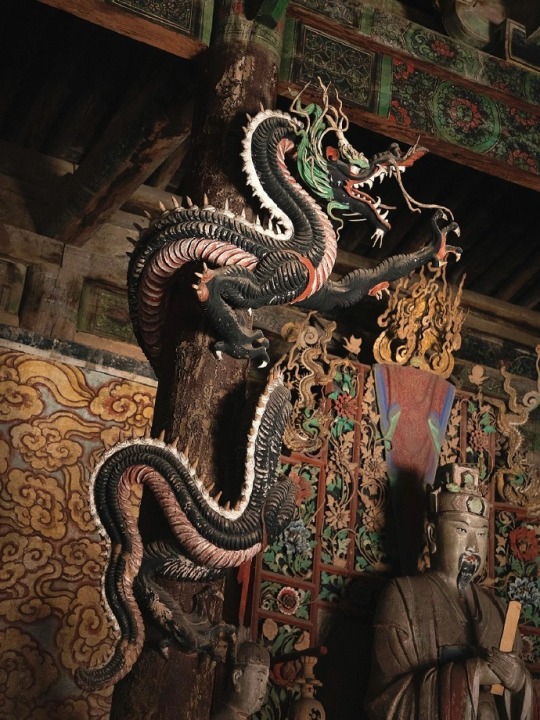
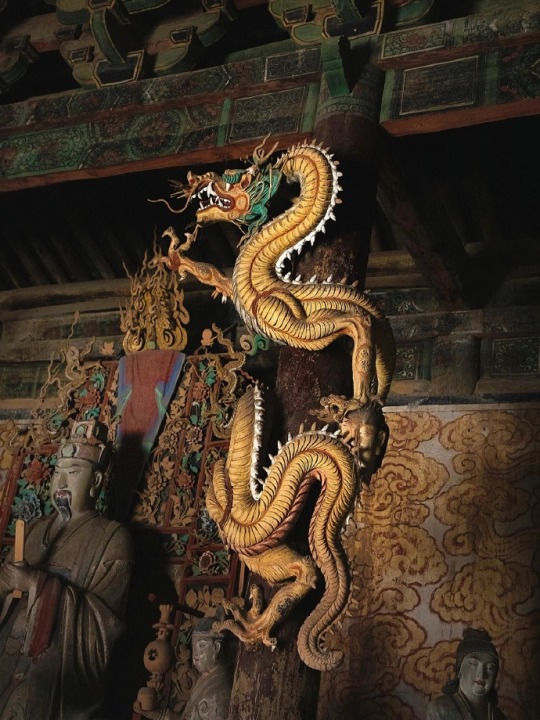
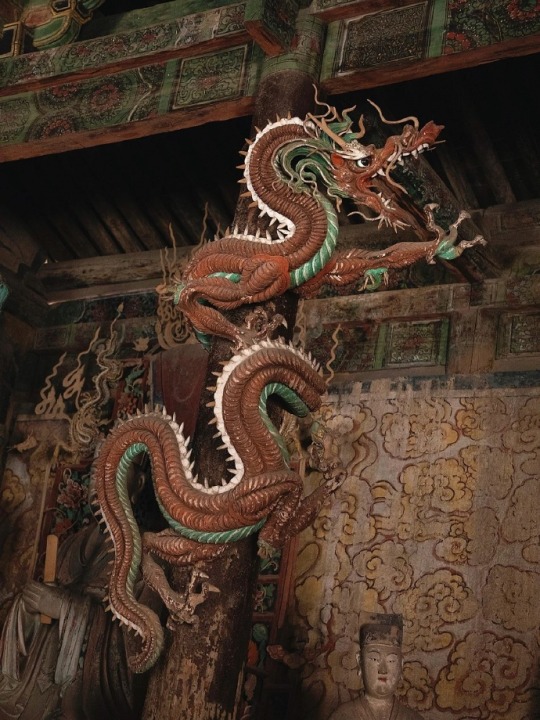
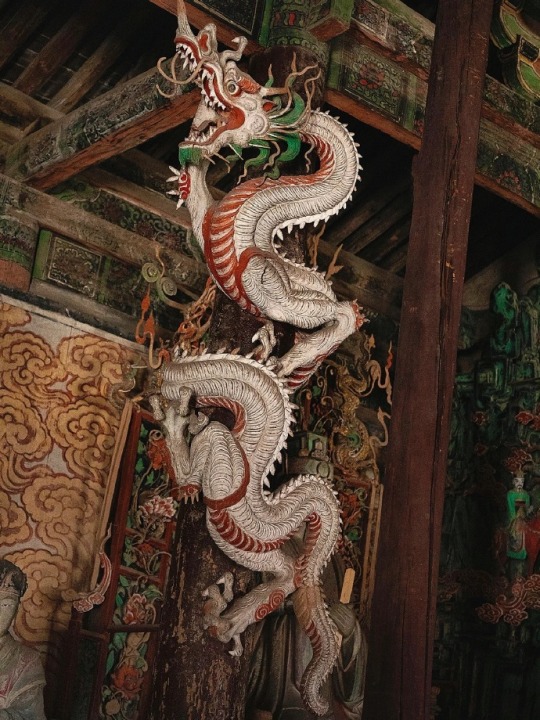

Mythological Realism: Elemental Dragons
Four-color coiled dragons on the pillars of the Supreme Talisman (Taifu) Temple (太符觀).
The dragons are painted in the colors of the primary elements, embodying the archetypal creative forces. In Chinese religious art, almost any concept can be expressed in the language of dragons.) Their children, descendants and relatives frolic on the temple walls among curly clouds.
In view of the striking liveliness, I would classify these images as mythological realism.)
Since its construction in the fifth year of the Jin dynasty (1200), the temple has been repeatedly expanded and supplemented with new buildings over the centuries. Most of the surviving statues are from the Ming dynasty.
The Supreme Talisman Temple is located in Fenyang (汾陽), Shanxi.
Photo: ©故尔耳
#ancient china#chinese culture#chinese art#chinese mythology#ming dynasty#taoist practices#religious art#chinese temple#Taoist temple#taoism#taoist#statue#sculptures#statues#daoism#jin dynasty#dragon#dragons#dragon art#creatures#wood carving#woodworking#temple architecture#wooden architecture#wooden buildings#chinese architecture
583 notes
·
View notes
Text
The Water Classic, Part 1
[This is the core Classic only, i.e. without the Commentary, however the headings, SJZ01, SJZ02, etc., indicates the corresponding scrolls within the much longer Commentary on the Water Classic.]
[The maps are primarily intended to illustrate the Classic. Place names have as far as possible been placed in accordance with the Historic Atlas of China, and the rivers drawn as straight lines between their closest vicinity to each place. The Classic is not error-free, as is made clear in the Commentary. Unless noted otherwise, discrepancies between the Atlas and the Classic have been resolved in favour of the Atlas. Cities, mountains, rivers and other features not in the Atlas have been placed by me to fit the description in the Classic.]
SJZ01
Kunlun Barrens崑崙墟 are to the north-west, the distance to the Song Heights嵩高 is 50 000 li, it is at the centre of the land. Its height is 11 000 li.

He River河水 sets out from their north-eastern corner, bends to flow south-east from them, and enters the Bo Sea渤海. Again it sets out outside the sea, and to the south arrive below Jishi Mountain積石山 which has the Stone Gates石門 [shimen].
SJZ02
Again south it enters Congling Mountain蔥嶺山, again it sets out from Congling蔥嶺 and then flows north-east. One of its sources sets out from a mountain south of Yutian State于闐國, flows north and combines with the He河 that sets out from Congling蔥嶺. Again it east it pours into the Puchang Sea蒲昌海. Again east it enters the Frontier, and passes south of Dunhuang敦煌, Jiuquan酒泉, and Zhangye Commanderies張掖郡, again east to pass north of Longxi's隴西 Heguan County河關縣.


Tao River洮水 comes flowing from the south-east to pour into it, again east to pass north of Jincheng's金城 Qianya County允吾縣, again east to pass north of Yuzhong County榆中縣, again east to pass the northern boundaries of Tianshui天水, again north-east to pass east of Wuwei's武威 Aowei County媼圍縣, again north-east to pass north of Tianshui's天水 Yongshi County勇士縣, again north-east to pass Maitian Mountain麥田山 at the northern boundaries of Anding安定.
SJZ03
Again north to pass west of Beidi's北地 Fuping County富平縣.

Again north to pass west of Shuofang's朔方 Linrong County臨戎縣, bends north-east from the county, arrives west of Hemu County河目縣, bends south to pass south if Wuyuan's五原 Xi'anyang County西安陽縣, bends east to pass south of Jiuyuan County九原縣, again east to pass south of Linwo County臨沃縣, again east to pass south of Yunzhong's雲中 Zhenling County楨陵縣, again east to pass north of Sha'nan County沙南縣, from east of the county bends south to pass west of Shaling County沙陵縣, again south to pass east of Chi City赤城, again south to pass west of Dingxiang's定襄 Tongguo County桐過縣, again south to pass east of Xihe's西河 Yinyang County圁陽縣.

Again south to pass west of Lishi County離石縣, again south to pass west of Zhongyang County中陽縣, again south to pass Tujun County土軍縣, again south to pass east of Shang commandery's上郡 Gaonu County高奴縣.
SJZ04
Again south to pass west of Hedong's河東 Beiqu County北屈縣, again south to pass west of Pishi County皮氏縣, again south to set from Longmen Mouth龍門口, Fen River汾水 comes from the east to pour into it, again south to pass west of Fenyin County汾陰縣, again south to pass west Puban County蒲坂縣, again south to arrive at Huayin's華陰 Tong Pass潼關, Wei River渭水 comes from the west to pour into it, again east to pass south of Hebei County河北縣, again east to pass north of Shan County陝縣, again east to pass south of Dayang County大陽縣, again east to pass the Dizhu Gaps砥柱間, again east to pass north of Pingyin County平陰縣, Qing River清水 comes from the north-west to pour into it
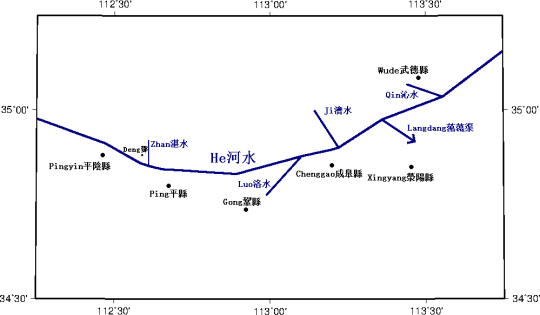
Again east it arrives at Deng鄧.
SJZ05
Again east it passes north of Ping County平縣, Zhan River湛水 comes from the north to pour into it, again east to pass north of Gong County鞏縣, Luo River洛水 from west of the county flows north to pour into it, again east it passes north of Chenggao County成臯縣, Ji River濟水 comes from the north to pour into it, again east to pass north of Xingyang County滎陽縣, Langdang Canal蒗蕩渠 sets out from there, again north-east to pass east of Wude County武德縣, Qin River沁水 comes from the north-west to pour into it
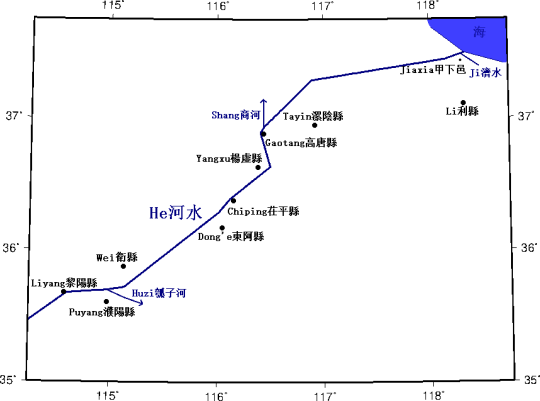
Again north-east to pass south of Liyang County黎陽縣, again north-east to pass south of Wei County衛縣, again north-east to pass north of Puyang County濮陽縣, the Huzi He瓠子河 sets out from there, again north-east to pass north of Dong'e County東阿縣, again north-east to pass west Chiping County茌平縣, again north-east to pass east of Gaotang County高唐縣, again north-east to pass east of Yangxu County楊虛縣, the Shang He商河 sets out from there, again north-east to pass north of Tayin County漯陰縣, again north-east it passes north of Li County利縣, again north-east it passes Jiaxia Town甲下邑, Ji River濟水 comes from the west to pour into, again north-east it enters the sea.
[According to the Commentary, and the Atlas, the Ji River entered the sea separate from the He.]

Fen River汾水 sets out from Guancen Mountain管涔山 north of Taiyuan's太原 Fenyang County汾陽縣, goes south-east to pass east of Jinyang County晉陽縣, Jin River晉水 flows from south-east of the county to pour into, again south Dongguo River洞過水 comes from the east to pour into it, again south to pass east of Pingtao County平陶縣, Wen River文水 comes flowing from the west to pour into it, again south to pass Guanjue Ford冠爵津, again south to enter the boundaries of Hedong河東, again south to pass west of Yong'an County永安縣, and successively east of Tang City唐城, again south to pass east of Yang County楊縣, goes south-west to pass west of Gaoliang Town高梁邑, again south to pass east of Pingyang County平陽縣, again south to pass east of Linfen County臨汾縣, again bends from south of the county to flow west, again west to pass south of Changxiu County長脩縣, again west to pass south of Pishi County皮氏縣, again west to arrive north of Fenyin County汾陰縣, and to the west pour into the He河.

Kuai River澮水 sets out from Gao Mountain 高山 east of Kuaijiao澮交 east of Hedong's河東 Jiang County絳縣, to the west passes south of that county, again south-west to pass south of Siqi Palace虒祁宮, again west to arrive at Wang Marsh王澤, and pours into the Fen River汾水.
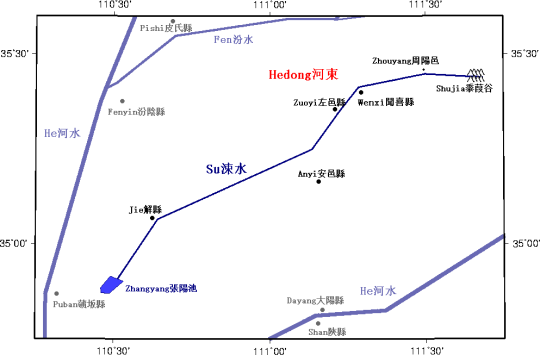
Su River涑水 sets out from Shujia Valley黍葭谷 in the mountains east of Hedong's河東 Wenxi County聞喜縣, goes west to pass south of Zhouyang Town周陽邑, again south-west to pass south of Zuoyi County左邑縣, again south-west to pass west of Anyi County安邑縣, again south to pass east of Jie County解縣, again south-west to pour into Zhangyang Pool張陽池.
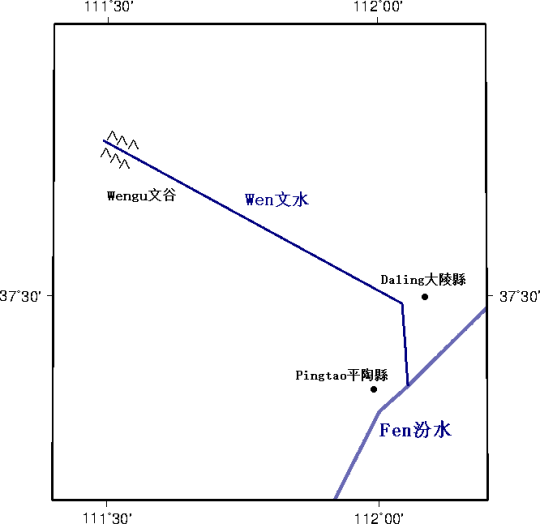
Wen River文水 sets out from Wen Valley文谷 in the mountains west of Daling County大陵縣, to the east arrives at that county, bends south to arrive north-east of Pingtao County平陶縣, and to the east enters the Fen汾.
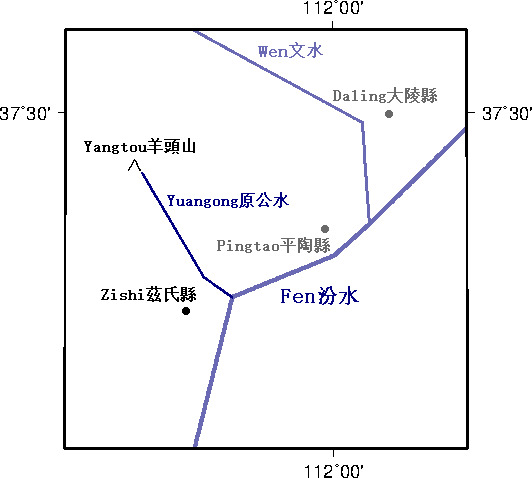
Yuangong River原公水 sets out from Yangtou Mountain羊頭山 west of Zishi County茲氏縣, to the east passes north of that county, and again east enters the Fen汾.
4 notes
·
View notes
Text
0 notes
Text

【常威近代史】(八百三十二回)
百團大戰
1940年8月20日,170架日本轟炸機再度瘋狂轟炸重慶,市區發生大火,不經不覺,日本利用空軍轟炸重慶已經維持咗一段長時間,有殺錯冇放過,幾多無辜平民百姓被炸死,根本無從統計。重慶蔣介石重慶政權面對空前壓力,加上英國人法國人出賣佢(其實都唔可以叫出賣,大家講利益啫),滇緬公路被封鎖,法國讓出殖民地越南供日軍出入補給,重慶已經成為孤島,仲守得幾耐亦根本冇人知道?日本人嘅想法亦都好簡單,打殘你蔣介石,汪精衛偽政權就會成為中華民國唯一合法政權,咁就一天光曬。不過除咗蔣介石重慶政權,神州大地上仲有中共嘅新四軍同八路軍,侵華戰爭已經到達第三個年頭,日本人亦都從來冇諗過戰事可以拖到第三年,中華民族嘅頑強同韌力出乎日本人嘅意料之外。中國地大物博,人又多,日本人以為好易啃得落,點不知道反而鯁咗骨,被拖入泥漿之中打摔角。
更加大鑊嘅係,由於日本人發動侵華戰爭後陷入進退維谷之境,同美國嘅關係亦都日趨緊張,彼此雖然係世仇(係美國人用黑船教日本仔著底褲架),但係兩個超級大國相隔一個遼闊嘅太平洋,地緣上大家可以各有各做,你唔理我,我唔理你,打吓咀炮過吓癮,其實都可以,無謂動刀動槍。歐洲嗰邊打生打死,其實日本大可以置身事外(其實美國都可以)。偏偏美國唔願意放棄響東方嘅龐大利益,口頭上同實質上都大力支持蔣介石政權苟延殘存,成為蔣介石背後嘅大金主。日本人簡直覺得你多舊魚,所以與其打蔣介石,不如直接打你羅斯福,偷襲你夏威夷珍珠港!重申一次,今時今日睇返日本人向美國發動戰爭,係以卵擊石!但係當時嚟講,未被閹割前嘅日本海軍力量絕對不在美國之下,更加唔好講之後決定性一戰中途島戰役嘅偶然性同幸運成份。(命運之神要站在美國一方,就叫天意)
8月20號,中日戰爭中,鼎鼎大名嘅「百團大戰」拉開序幕,八路軍105個團從今日夜間出發,響總部嘅統一指揮下,同時向正太路、同蒲路、平漢路嘅日偽軍據點發動猛烈攻擊。依一次行動嘅目的,係要徹底切斷正太路交通,以消除日偽軍進行嘅「囚籠政策」,消除日軍對華北抗日根據地嘅威脅。
1939年3月,日本華北方面軍司令多田駿(1882-1948)制定咗「囚籠政策」,以鐵路為柱,以公路為鏈,以碉堡為鎖,輔之以封鎖溝(即係戰壕)、封鎖牆從日軍控制地��向抗日根據地構成網狀嘅囚籠!一年以嚟,日軍響華北修復修築鐵路1870公里、公路15000公里,興建新碉堡,建立2700多個據點,日軍憑住呢啲設施對抗日根據地進行咗多次嘅分區「掃蕩」、「清鄉」同埋「蠶食」。
百團大戰開始之後,晉察冀軍區19個團,5支遊擊隊先後攻剋娘子關同埋井陘新礦,佔領東王含、北峪、乏驢嶺等車站同據點,129師10個團同炮兵團,向正太路嘅平定至榆次段發起進攻,攻剋蘆家莊、桑掌、上湖、張凈,並搶佔咗陽泉西南嘅獅堖山高地。數日之間,129師控制咗正太路西段除陽泉、壽陽以外嘅大部分對點。120師20個團破襲咗同蒲路北段同汾離、太汾,公路等主要公路線,攻剋陽方口、康家會、豐潤村等地。在此期間內,平漢、同蒲、德石、北寧、白綏、津蒲等鐵路線上嘅日偽軍據點,遭到八路軍大規模破襲。一時間,正太路完全癱瘓,平漢、同蒲路中斷,井陘煤礦停產。
根據八路軍總部徹底摧毁正太路同同浦路忻縣至朔縣段嘅部署,百團大戰嘅第二階段喺9月20號開始。晉察冀軍區8個團、3支遊擊隊2個獨立營發動淶丘戰役,先後攻佔三甲村、東團堡、南坡頭同搶風嶺。129師8個團進攻榆遼公路,一度佔領榆社城。120師對同蒲路北段發動攻擊,令到同蒲鐵路再次中斷。冀中軍區多次進攻任丘、河間、大城。冀南、太行、太嶽軍區部隊亦投入了破襲戰。百團大戰,中共將領彭德懷(1898-1974)一戰成名!戰事持續到1941年1月尾先正式結束。百團大戰中,日軍亦用了戰爭公約所禁止嘅毒氣與生物武器展開反撲。
百團大戰打響後彭德懷得到中共中央嘉獎,事後仲榮獲國民政府頒發獎章和蔣介石親自發出嘉獎令。但後來彭德懷也一度受到毛澤東等人批評,認為佢冇執行毛澤東嘅抗戰相持時期軍事戰略(即「山地游擊戰為主,可能條件下進行陣地戰,避免大規模決戰」),打成「消耗戰」,過早暴露和不必要犧牲咗中共領導一些抗日力量。為此彭在華北座談會上被批了40天,文革中挨批���造反派材料中出現咗「彭德懷幹這麼大事也不和我商量,我們的力量大暴露了,後果將是很壞」說法,不過當代已經予以平反。
8月21號,上海《大美晚報》,編輯程振章被汪偽特務刺殺。8月22號,夏衍(1900-1995)主編嘅《野草》喺桂林創刋。8月23號,中國軍隊剋服娘子關。8月24號,韓德勤部隊20個團猛攻姜堰、曲塘、南安一帶嘅新四軍。8月27號,廣東南上、下川島被中國軍隊收復,同日,上海英軍撤退回國。8月28號,國民政府譴責法國允許日本假道越南侵華。8月29號,中動向國民黨最高國防會議提出四項要求,包括遷都蘭州、改組行政院、調整中央及地方人事外交一元化,當然悉數被國民黨所拒絕。
1940年8月於焉結束。
#常威💀 #蔣介石平反系列 #佛經抄寫員 #中日戰爭 #中華民國
1 note
·
View note
Text
有拿香拜祖先的都要知道(收藏)。(網路資料)
我們的祖先來自何處?
我們的語言出自何處?
不要被意識形態民粹政客們洗腦騙了!
「堂號」!無論您是400年前、200年前、77年前、或何時來台,都是台灣人也是中國人,只有「堂號」能讓您完全了解。
「台灣人」的祖先大都是來自中國北方的中原地區,祖先為了逃避北方匈奴的侵略,而南遷到中國大陸東南沿海地區,所以「台灣人」大都是來自北方的中原漢人。
「五胡亂華」之後,華北經過長期戰亂,原先在河洛地區的(河圖與洛書,是中國古代傳說中,上天授與的圖象、數列)。
知識分子、士、農、工、商…等紛紛逃亡到江南地區避亂,也有族群避難遷徙,輾轉來到閩南泉州、漳州、潮州 、汀州或梅州、惠州…等地區定居。
河洛叫做「河圖與洛書」,河洛就地區來講,就是中國河南、洛陽一帶地區,廣義泛指「中原」。
為了讓後代子孫認識自己祖先的來處,使用「堂號」讓不同時間到達的移民,可以辨認自己的宗親,得到暫時的照顧。
久而久之,「堂號」成了姓氏宗親聯誼的代號。
「堂號」也可以使後代子孫認識自己祖先發源處,可以知道先人從哪來?
世界只有中國有「堂號」,我們不能讓「堂號」消失。
現今中華民族的族群當中,「堂號」最完整的只剩下客家族群。
堂號即祠堂的名稱或稱號,主要用於區別姓氏、宗族��家族、地名(姓氏宗族的發源地)。
堂號除在祠堂使用外,還會在 族譜、宅院、牌位、墓碑 等處使用。
以下我們從堂號來參考祖先從哪裡來?
濟陽堂:
丁、卞、江、柯、卻、陶、庾、蔡。後漢設濟陰國,晉改濟陽郡,在山東定陶縣地。
西河堂:
卜、苟、林、卓、宰、靳。
漢時的郡名,今內蒙古(綏遠)鄂爾多斯地方,以及陝北、山西離石一帶。
河南堂:
於、山、方、毛、元、平、向、利、苟、邱、俞、陸、褚、廉、種。今河南陽縣。
東魯堂:孔。
孔子生於魯,地因人而名,故叫東魯。
雁門堂:
文、田、童、農。
戰國時為趙地,漢為郡,地當山西舊代州,寧武以北及朔平、大同一帶。
隴西堂:
牛、辛、李、時、彭、董。
秦郡名,地當甘肅舊蘭州、鞏昌、秦州諸府。
天水堂:
尹、皮、艾、狄、桂、姜、秦、莊、趙、嚴、上官。
漢時郡名,在甘肅渭縣境,即今伏羌地。
平陽堂:
仇、汪、巫、來、常、鳳、管、衛、歐、饒。
三國魏郡名,在山西臨汾縣境。
吳興堂:
水、尤、沈、明、姚、施。三國吳郡名,今浙江省吳興地。
太原堂:
王、羊、祁、易、武、祝、宮、溫、霍、閻、尉遲。
太原、汾州二府及保德、平定、忻州各地。
高平堂:巴、范。
漢時國名,今安徽省盱貽縣境。
南陽堂:
白、束、呼、姬、許、隆、葉、翟、韓、樂、鄧。
秦時郡名,泛指河南省南陽及湖北襄陽一帶。
京兆堂:
申、史、宋、別、冷、杜、車、宗、段、計、韋、晁、郜、浦、象、康、舒、雍、壽、酆、黎、皇甫。
漢三輔之一,地轄長安以東至華縣一帶。
渤海堂:
甘、封、高、歐陽。
漢郡名,地領河北省河間、滄縣、安次各地,南至山東吳棣境。
汝南堂:
左、言、汝、周、南、殷、商、梅、廖、袁、藍。
漢郡名,地轄河南舊汝寧、陳州二府及安徽穎州府。
武陵堂:
冉、華、龍、龔、顧。
漢時郡名,今湖南省常德縣地。
上黨堂:
包、尚、連、鮑、樊。
秦時郡名,在山西東南部,今長子縣境。
陳留堂:
伊、阮、虞、謝。
漢時郡名,晉為國,今河南陳留縣,後移至開封。
上谷堂:
成、侯、冠、��。
秦郡名,地轄保定、易州、宣化、順天諸府,均在河北省。
沛國堂:朱。
漢時設郡,後漢改國,在安徽宿縣境。
晉陽堂:
匡、唐、景。
秦漢時縣名,今山西太原地。
新安堂:古。
三國吳郡名,在浙江省淳安縣。
武威堂:
石、安、賈。
漢武帝時郡名,即甘肅省武威縣地。
樂安堂:任。
南朝宋郡名,隋癈,在山東廣饒縣。
馮翊堂:吉、雷。
漢時郡名,為左馮翊轄地,即陝西大荔縣地。
中山堂:
仲、湯、藺。
春秋時國名,屬北狄鮮虞國地,今河北省正定縣境。
西平堂:池。
東漢郡,今甘肅西寧縣。
安定堂:
伍、胡、席、梁、程。
漢時郡名,在甘肅舊平涼、固原、涇州境。
東海堂:
有、茅、徐。
漢時置郡,地當山東兗州東南,江蘇邳縣以東。
河東堂:
旅、薛、裴、儲、聶。
秦時郡名,即山西西夏縣地。
下邳堂:闕。
後漢時國名,即江蘇邳縣地。
延陵堂:吳。
春秋時吳邑,季札受封延陵,今江蘇武進縣地。
廬江堂:何。
漢時郡名,在安徽廬江縣境。
北海堂:邢、郎。
漢郡名,東漢改國,地領山東益都以東至掖縣一帶。
平陵堂:孟。
春秋時齊邑,今山東歷城縣境。
彭城堂:
金、劉、錢。
漢郡名,今江蘇銅山縣地。
清河堂:
房、傅、張。
漢時郡名,地當河北清河、故城、棗強、南宮諸縣,及山東清平、恩縣、冠縣、高唐、臨清、武城一帶。
東平堂:花。
漢國名,即山東省東平縣。
博陵堂:邵。
晉國名,後改郡,今河北省安平縣境。
山陽堂:岳。
漢郡名,故城在河南修武縣,曹丕篡漢,廢獻帝為山陽公。
滎陽堂:
昌、潘、鄭。
戰國時韓地,今河南省滎陽、成皋一帶。
臨海堂:屈。
三國吳,分會稽東部置臨海,在浙江省,舊稱台州。
范陽堂:
鄒、簡、燕。
范陽是古郡名,即今河北省涿縣地。
齊郡堂:
查、晏、覃、富、譚。
漢時郡名,後改為國,今山東臨淄地。
高陽堂:紀、耿。
漢時縣名,今河北省高陽縣地。
敦煌堂:洪。
漢時郡名,今甘肅西部敦煌縣。
魏郡堂:柏。
春秋時國名,在山西芮城縣境。
扶風堂:
馬、班、祿、萬、魯。
隋時置郡名,今陝西省扶風、鳳翔一帶。
千乘堂:倪。
漢時郡名,在山東地城、益都一帶。
會稽堂:夏。
秦郡名,地當江蘇東部、浙江西部,即今紹興。
河內堂:
苟、荀、司馬。
漢郡名,地當河南省黃河與太行山之間,今武陵、沁陽一帶。
廣陵堂:貢、盛。
漢國名,後改郡,今江蘇都縣地。
薛郡堂:海。
秦時郡名,地轄山東西南部、江蘇東北部。
河間堂:凌、章、詹。
漢國名,後魏改郡,在河北獻縣及河間一帶。
南昌堂:塗。
漢縣名,在江西南昌地,洪州塗氏為豫章望族。
豫章堂:羅。
漢郡名,在江西南昌縣地。
潁川堂:
陳、鄔、賴、鍾。
秦郡名,地轄河南舊許州、陳州、汝寶、汝州諸府,蓋指潁水流��。
護國堂:
逢、邊、戴、稽。
春秋時陳焦邑,今安徽省亳縣地。
餘杭堂:隗。
隋郡名,唐復為杭州,今浙江杭縣。
汾陽堂:郭。
漢地名,唐併入陽曲,在山西省,唐將郭子儀受封於此,因而名傳。
瑯琊堂:
符、雲、諸葛。
秦郡名,地轄舊山東兗、音、沂、萊四府,後漢為國,在臨沂縣境。
廣平堂:
游、賀、談。
漢郡名,後改為國,今河北雞澤縣地。
江夏堂:費、黃。
漢郡名,在湖北雲夢境。
遼西堂:項。
秦郡名,地轄永平、承德、朝陽、錦州、新民一帶,在遼寧與河北間。
平原堂:東方。
漢郡名,在山東舊武定、濟南二府之西,及樂陵、長清一帶,即平原縣地。
頓丘堂:葛、司空。
春秋衛邑,在河南省濬縣。
弘農堂:楊。
漢時郡名,在河南省靈寶縣境。
百濟堂:福。
春秋時國名,在今朝鮮半島。
內黃堂:駱。
漢時縣名,今河南省內黃縣地。
江陵堂:熊。
春秋時楚郢都,漢置縣,宋改都,今湖北江陵地。
鉅鹿堂:魏。
秦郡名,晉為國,今河北鉅鹿、寧晉一帶。
蘭陵堂:蕭。
晉時郡名,在山東嶧縣,南朝宋移昌盧,在滕縣境。
解梁堂:關。
春秋時晉邑,地領山西解縣、臨晉、虞鄉諸地,後漢關羽,即解人也。
燕山堂:竇。
遼時燕京,宋改燕山府,地領河北省北部及東北部。
武功堂:蘇。
漢郡名,在陝西郿縣境,今設武功縣。
始平堂:
翁、馮、龐。
晉郡名,三國魏改始平,在咸陽附近。
梁國堂:墨、橋。
漢時梁國,後魏改郡,唐改宋州,在河南商丘縣境。
濟南堂:伏、寧。
漢初置郡名,即今山東歷城縣境。
平昌堂:
紅、孟、管、離。
三國魏置郡名,治安丘,在今山東安丘縣地。
濮陽堂:爰。
漢縣名,後魏改郡,即古帝丘,在河北濮陽縣及山東濮縣一帶。
著存堂:呂。
福建省詔安縣秀篆鎮。
殷禮堂:宋。
陝西西安市,陝西西河郡。
我們現在講的「台語」正確名稱~不是台灣話、更不是閩南話、也不是福建話,正確叫做~「河洛話」!
河洛話:源自河南洛陽,俗稱中原話,在唐朝時期就是講河洛話,唐朝武則天就是講河洛話;日本現在廟宇和尚念經朗誦的語言就是用河洛話!
0 notes
Text
粒史學加000386《史記》卷二十九〈河渠書〉04:地圖上可以的事,現實上就一定可以?
──────────原文────────── 其後河東守番系言:「漕從山東���,歲百餘萬石,更砥柱之限,敗亡甚多,而亦煩費。穿渠引汾溉皮氏、汾陰下,引河溉汾陰、蒲阪下,度可得五千頃。五千頃故盡河壖棄地,民茭牧其中耳,今溉田之,度可得穀二百萬石以上。穀從渭上,與關中無異,而砥柱之東可無復漕。」天子以為然,發卒數萬人作渠田。數歲,河移徙,渠不利,則田者不能償種。久之,河東渠田廢,予越人,令少府以為稍入。 其後人有上書欲通褒斜道及漕事,下御史大夫張湯。湯問其事,因言:「抵蜀從故道,故道多阪,回遠。今穿褒斜道,少阪,近四百里;而褒水通沔,斜水通渭,皆可以行船漕。漕從南陽上沔入褒,褒之絕水至斜,閒百餘里,以車轉,從斜下下渭。如此,漢中之穀可致,山東從沔無限,便於砥柱之漕。且褒斜材木竹箭之饒,擬於巴蜀。」天子以為然,拜湯子卬為漢中守,發數萬人作褒斜道五百餘里。道果便近,而水湍石,不可漕。 ──…

View On WordPress
0 notes
Text











Twenty-eight Constellations From The Temple Of Supreme Talisman
Pottery figurines of the Twenty-Eight Constellations from the Ziwei Pavilion (紫薇閣) in Supreme Talisman (Taifu) Temple (太符觀) are quietly chatting.
The Taoist temple itself, located in Fenyang (汾陽), Shanxi, was built in the fifth year of the Jin dynasty (1200). The Jade Emperor is enshrined in the main hall. The other halls on the both sides are dedicated to the Holy Mother of Houtu (后土聖母), aka Xiwangmu, The Queen Mother of the West, and to the Five Sacred Mountains (五嶽).
The figurines, just like some of the buildings, date back to the Ming dynasty. Each is about half a meter high. Of the original number, eight have been lost over the centuries. The rest were moved to the Shanxi Museum (山西博物院).
Photo: ©雪夜魚舟
#ancient china#chinese culture#chinese art#taoism#chinese mythology#taoist practices#taoist magic#ming dynasty#jin dynasty#pottery#ceramic art#ceramic#chinese miniatures#miniature art#sculpture art#clay sculpting#miniatures#religious art#chinese temple#daoism#taoist#taoist immortal#chinese astrology#astrology#zodiac#constellations
69 notes
·
View notes
Text
Commanderies and States of Western Han, Part 2
Taiyuan
Taiyuan commandery太原郡, Qin set it up [in 247 BC]. Has a salt official at Jinyang晉陽. Belongs to Bing province并州. 169 863 households, 680 488 people. Has a House Horse official[a]. 21 counties:
[1]Jinyang晉陽, formerly in the Poetry Tang state唐國. King Cheng of Zhou wiped out Tang唐 and ennobled his younger brother Shuyu. Long Mountain龍山 is to the north-west. Has a salt official. The Jin River晉水 sets out form there, to the east it joins the Fen汾[b].
[2]Suiren葰人[c].
[3]Jiexiu界休, Mang called it Jiemei界美[d].
[4]Yuci榆次. Tushui district涂水鄉, Jin's Grandee Zhi Xuwu's town. Gengyang district梗陽鄉, Wei Wu's town. Mang called it Dayuanting大原亭[e].
[5]Zhongdu中都.
[6]Yuli于離, Mang called it Yuhe于合.
[7]Zishi茲氏, Mang called it Zitong茲同.
[8]Langmeng狼孟, Mang called it Langzhou狼調.
[9]Wu鄔, the Nine Marshes九澤 are to the north. This is Zhaoyuqi昭餘祁, the swamp of Bing province并州. Jin's Grandee Sima Mimou's town[f].
[10]Yu盂, Jin's Grandee Yu Nei's town.
[11]Pingtao平陶, Mang called it Duorang多穰.
[12]Fenyang汾陽, to the north are the mountains from where the Fen River汾水 sets out, to the south-west arriving at Fenyin汾陰 it joins the He河, passing through 2 commanderies, travelling 1 340 li, the irrigator of Ji province.
[13]Jingling京陵, Mang called it Zhicheng致城[g].
[14]Yangqu陽曲[h].
[15]Daling大陵, has an iron official. Mang called it Daning大寧.
[16]Yuanping原平
[17]Qi祁, Jin's Grandee Jia Xin's town. Mang called it Shi示.
[18]Shang'ai上艾. The Mianman River綿曼水 to the east arrives at Puwu蒲吾, and enters the Hutuo River虖池水[i].
[19]Lüsi慮虒[j].
[20]Yangyi陽邑, Mang called it Fanrang繁穰 .
[21]Guangwu廣武. Juzhu句注 and Jiawu Mountains賈屋山 are to the north.The Chief Commandant's seat. Mang called it Xinhuan信桓[k].
[a]Your Subject Zan says: “Han had the House Horse Stable家馬廄, one stable had ten thousand horses. At the time, since the border and outside had affairs, they allotted them to come and be here. The “House Horse” later changed name to Churning [dong挏] [milk] Horse.”
Shigu says: “ 挏 is pronounced dong動.”
[b]Your Subject Zan says: “Where is spoken of as Tang唐 is the present Hedong's河東 Yong'an永安, the distance to Jin is 400 li.”
Shigu says: “Zan's explanation is correct.”
[c]Ru Chun says: “Pronounced suǒ璅.”
Shigu says: “Also pronounced shān山 + guǎ寡.”
[Baxter & Sagart: 葰: not listed, shān山: (sr- + -ean A), guǎ寡: (k- + -wae B), (sr- + -wae B): no examples.]
[d]Shigu says: “休 pronounced xǔ許+ qiú虯.”
[Baxter & Sagart: xiū休: (x- + -juw A), xǔ許: (x- + -jo B), 虯: not listed.]
[e]Shigu says: “ 涂 pronounced tu塗. 梗 pronounced geng鯁.”
[f]Shigu says: “Pronounced yī一 + hù戶. Also pronounced yú於+ jù據.”
[Baxter & Sagart: 鄔: not listed, yī一: ('- + -jit D), hù戶: (h- + -u B). ('- + -u B): not listed.
Yú於: ('- + -jo A), jù據: (k- + -jo C), ('- + -jo C): not listed. 烏: (- + -u A).]
[g]Shigu says: “Precisely Jiujing九京.”
[h]Ying Shao says: “The He河 for 1 000 li is one curve, this must be on its sunny-side, and for that reason it was called Yangqu陽曲.”
Shigu says: “Emperor Wen of Sui, since his family name was Yang楊, hated the title of Yangqu陽曲, and therefore changed its county to be Yangzhi陽直, now then we have restored the old name for it.”
[i]Shigu says: “虖 pronounced hu呼. 池 pronounced tú徒 + hé何.”
[Baxter & Sagart: chí池: (dr- + -je A), tú徒: (d- + -u A), hé何: (h- + -a A). (d- + -a A): tuó (驒鼉紽沱)]
[j]Shigu says: “Pronounced Luyi廬夷.”
[k]Shigu says: “Jiawu Mountain is precisely of where the Historical Records states: “Count Xiang of Zhao went north to climb Xiawu夏屋."”
Shangdang
Shangdang commandery上黨郡, Qin set it up [in 247 BC?]. Belongs to Bing province并州. Has Shangdang Pass上黨關, Hukou Pass壺口關, Shixing Pass石研關, Tianjing Pass天井關[a]. 73 798 households, 337 766 people. 14 counties:
[1]Changzi長子, where was Zhou's Scribe Xin Jia's fief. Lugu Mountain鹿谷山, Zhuozhang River濁漳水 sets out form there, to the east arriving at Ye鄴, it enters the Qingzhang清漳[b].
[2]Zhunliu屯留, Sang Qin tells of of it: “Jiang River絳水 sets out from the south-west. To the east it enters the sea[c].
[3]Yuwu余吾.
[4]Tongdi銅鞮, has Shangsi Precinct上虒亭, Xiasi Settlement下虒聚[d].
[5]Zhan沾. Damin Valley大黽谷, Qingzhang River清漳水 sets out from there, to the north-east arriving at Yicheng邑成, it enters the Great He大河, passing through 5 commanderies, traveling 1 680 li. The stream of Ji province冀州[e].
[6]Nieshi涅氏, Nie River涅水[f].
[7]Xiangyuan襄垣. Mang called it Shangdangting上黨亭.
[8]Huguan壺關, has Yangchang Slope羊腸版. The Zhan River沾水 to the east arriving at Zhaoge朝歌, it enters the Qi淇[g].
[9]Xuanshi泫氏. Yang Valley楊谷, the Jue River絕水 sets out from there, to the south arriving at Yewang野王 it enters the Qin沁[h].
[10]Gaodu高都. Wan Valley莞谷, Dan River丹水 sets out from there, to the south-east it enters the Xuan River. Has Tianjing Pass天井關[i].
[11]Lu潞, formerly the Count of Lu's state潞子國.
[12]Yishi陭氏[j].
[13]Yang'e陽阿.
[14]Guyuan穀遠. Yangtou Mountain羊頭山 and Shimi Valley世靡谷. The Qin River沁水 sets out from there, to the south-east arriving at Xingyang滎陽 it enters the He河, passing through 3 commanderies, and travelling 970 li. Mang called it Gujin穀近[k].
[a]Shigu says: “研 is pronounced Xing形.”
[b]Shigu says: “Chang read as in the chang長 of long and short, in the present custom it has become the zhang長 of old and young. A mistake.”
[c]Shigu says: “ ��� pronounced zhun純.
[d]Shigu says: “虒 pronounced si斯.”
[e]Ying Shao says: “Zhan River 沾水 sets out from Hu Pass壺關.”
Shigu says: “沾 is pronounced ta他 + jian兼.”
[Baxter & Sagart: zhān沾: (tr- + -jem A), tā他: (th- + -a A), jiān兼: (k- + -em A). (th- + -em A): tiān 添.]
[f]Shigu says: “Nie River涅水 sets out from there, and for that reason used it to name the county. niè涅 pronounced nǎi乃 + jié結.”
[Baxter & Sagart: 涅: not listed, nǎi乃: (n- + -oj B), jié結: (k- + -et D). (n- + -et D): not listed.]
[g]Ying Shao says: “The Marquis of Li's state黎侯國 is the present Li Precinct黎亭.”
[h]Ying Shao says: “The Classics of Mountains and Seas: from where the Xuan River泫水 sets out.”
Shigu says: “泫 pronounced gōng工 + xuán玄)
[Baxter & Sagart: 泫: not listed, gōng工: (k- + -uwng A), xuán玄: (h- + -wen A). (k- + -wen A): not listed.
[i]Shigu says: “ 莞 pronounced wan丸.”
[j]Shigu says: “pronounced yú於 + yì義.”
[Baxter & Sagart: 陭: not listed, yú於: ('- + -jo A), yì義: (ng- + -je C). ('- + -je C) not listed.]
[k]Shigu says: “Presently the Qin River沁水 enters the territory of Huai province's懷州 Wuzhi武陟 county to enter the He河. This states that it arrives at Xingyang滎陽, suspect the transmitted writings is faulty.”
Henei
Henei commandery河內郡. 1st Year of Emperor Gao [206 BC], it became Yin state殷國. 2nd Year [205 BC], changed the name. Mang called it Houdui後隊. Belongs to Sili司隸. 241 246 households, 1 067 097 people. 18 counties:
[1]Huai懷. Has a labour official. Mang called it Henei河內.
[2]Ji汲.
[3]Wude武德[a].
[4]Bo波[b].
[5]Shanyang山陽. Eastern Taihang Mountain東太行山 is to the north-west[c].
[6]Heyang河陽, Mang called it Heting河亭.
[7]Zhou州.
[8]Gong共, formerly a state. Bei Mountain北山, Qi River淇水 sets out from there, to the east arriving at Liyang黎陽 it joins the He河[d].
[9]Pinggao平皋[e].
[10]Zhaoge朝歌, where was Zhou紂's capital. Where was King Wu of Zhou's younger brother Kangshu's fief, changing the name to Wei衛. Mang called it Yage雅歌.
[11]Xiuwu脩武[f].
[12]Wen溫, formerly a state,Yixing己姓, where was Su Fensheng's fief.
[13]Yewang野王, Taihang Mountain太行 is to the north-west. Where Lord Yuan of Wei was abducted by Qin, moving from Puyang濮陽 to there. Mang called int Pingye平野[g].
[14]Huojia獲嘉, formerly Ji's汲 Xinzhong district新中鄉. When Emperor Wu travelled through it he changed the name.
[15]Zhi軹[h].
[16]Qinshui沁水[i].
[17]Longlü隆慮. The Guo River國水 to the north-east arrives at Xincheng信成 and joins the Zhangjia He張甲河, passing through 3 commanderies, travelling 1 840 li. Has an iron official[j].
[18]Tangyin蕩陰. Tang River蕩水 to the east arriving at Neihuang Marsh內黃澤. Xi Mountain西山, You River羑水 sets out from there, likewise arrives at Neihuang內黃 to join the pond. Has Youli City羑里城, where the Earl of the West was imprisoned[k].
[a]Meng Kang says: “When the First August toured the east, he set it up, himself considered the martial virtue [wude] that had settled Under Heaven.”
[b]Meng Kang says: “Presently has Chi City絺城, where Duke Wen of Jin obtained the bestowal.”
[c]Shigu says: “háng行 is pronounced hú胡 + láng郎.”
[Baxter & Sagart: háng行: (h- + -ang A), xíng行: (h- + -aeng A), hú胡: (h- + -u A), láng郎: (l- + -ang A). (h- + -ang A): háng行.]
[d]Meng Kang says: “The Earl of Gong entered to be among the Three Excellencies.”
Shigu says: “共 is pronounced gong 恭.”
[e]Ying Shao says: “The Marquis of Xing邢 moved from Xiangguo襄國 to here. At the time of Duke Huan of Qi, the people of Wei衛 invaded Xing邢. Xing邢 shifted to Yiyi夷儀, its territory belonged to Jin, and they titled it Xingqiu邢丘. Since it was on the high bank [gao皋] of the He河, and the lay of the land was flat [ping平] and even, they called it Pinggao平皋.”
Your Subject Zan says: “In the Transmittals of the Spring and Autumn, the people of the Di狄 invaded Xing邢, and Xing邢 shifted to Yiyi夷儀, they did not arrive here. Presently, west of Xiangguo襄國 there is a Yiyi City夷儀城, the distance to Xiangguo襄國 a hundred li. The xing here is the name of this hill [qiu丘], it is not the state.
Shigu says: “Ying's explanation is mistaken. When the Transmittals of Mister Zuo says: “The Marquis of Jin sent off a woman to Xingqiu邢丘,” it perhaps speaks of this, and that is all.
[f]Ying Shao says: “Where Jin first opened up Nanyang南陽 is the present Nanyang City南陽城. Qin changed it to be called Xiuwu脩武.”
Your Subject Zan says: “Book of Han Fei: “King Zhao of Qin went beyond Zhao's趙 Changping長平, and to the west invaded Xiuwu脩武.” At the time Qin had not yet united Under Heaven, but the name of Xiuwu脩武 had been for a long time.”
Shigu says: “Zan's explanation is correct.”
[g]Meng Kang says: “Formerly Xing state故邘, the present Yuting邘亭.”
Shigu says: “ háng行 is pronounced hú胡 + láng郎.”
[h]Meng Kang says: “Yuan District 原鄉 was besieged by Duke Wen of Jin.”
Shigu says: “Pronounced zhi只.”
[i]Shigu says: “qìn沁 is pronounced qiān千 + jìn浸.”
[Baxter & Sagart: 沁: not listed, qiān千: (tsh - -en A), 浸 not listed.”
[j]Ying Shao says: “Longlü Mountain隆慮山 is to the north. To avoid the Young Emperor's name, it was changed to be called Linlü林慮.”
Shigu says: “慮 is pronounced lu廬.”
[k]Shigu says: “ 蕩 is pronounced tang湯. yǒu羑 is pronounced yáng羊 + jiǔ九.”
[Baxter & Sagart: 羑: not listed, yáng羊: (y- + -jang A), jiǔ九: (k- + -juw B), (y- + -juw B): yǒu��.]
Henan
Henan commandery河南郡, formerly Qin's Sanchuan commandery三川郡 [established in 249 BC]. Emperor Gao changed the name. Luoyang has 52 839 households. Mang changed it to Xinxiang信鄉 of Baozhong保忠. Belongs to Sili司隸. 276 444 households, 1 740 279 people. Has an iron office, a labour office. Ao granary is in Xingyang. 22 counties:
[1]Luoyang雒陽, the Duke of Zhou moved the people of Yin殷, this was Chengzhou成周. In the Spring and Autumn, 23rd Year of Duke Zhao of Lu [519 BC], Jin gathered the various lords at Diquan狄泉, using its territory as the city of Dachengzhou大成周, the residence of King Jing. Mang called it Yiyang宜陽[a].
[2]Xingyang滎陽, Bian River卞水 and Ping Pool馮池 are both to the south-west. Has Langdang Canal狼湯渠, the head accepts the Ji泲, to the south-east arriving at Chen陳 it enters the Ying潁, passing through 4 commanderies, travelling 780 li[b].
[3]Yanshi偃師. Shi District尸鄉, capital of Tang of Yin. Mang called it Shicheng師成[c].
[4]Jing京[d].
[5]Pingyin平陰[e].
[6]Zhongmou中牟. Putian Marsh圃田澤 is to the west, the swamp of Yu province豫州. Has Guanshu Town筦叔邑. Marquis Xian of Zhao moved from Geng耿 to here[f].
[7]Ping平, Mang called it Zhiping治平.
[8]Yangwu陽武, has the Bolang Sands博狼沙. Mang called it Yanghuan陽桓[g].
[9]Henan河南, formerly the territory of Jiaru郟鄏. King Wu of Zhou moved the Nine Tripods. The Duke of Zhou presented the Grand Peace. Encampment used as capital. This was the Royal City. Arriving at King Ping, he resided there[h].
[10]Goushi緱氏, Liu Settlement劉聚, Zhuo's Grandee Liuzi's town. Has the Transcendent of Yanshou City's Shrine延壽城仙人祠. Mang called it Zhongting中亭[i].
[11]Quan卷[j].
[12]Yuanwu原武, Mang called it Yuanhuan原桓.
[13]Gong鞏, the residence of Eastern Zhou.
[14]Gucheng穀成, in the Tribute of Yu, Chan River瀍水 sets out from the north of Qian Precinct㬱亭, and to the south-east enters the Luo雒[k].
[15]Gushi故市.
[16]Mi密, formerly a state. Has Dakui Mountain大騩山, Yi River潩水 sets out from it, to the south arriving at Linying臨潁 it joins the Ying潁[l].
[17]Xincheng新成, 4th Year of Emperor Hui [191 BC], set it up. Manzhong蠻中, formerly the Rong's Count of Man's State蠻子國.
[18]Kaifeng開封, Feng Pool逢池 is to the north-east. Some call it the Feng Marsh逢澤 of Song[m].
[19]Chenggao成皋, formerly Hulao虎牢. Some call it Zhi制[n].
[20]Yuanling苑陵. Mang called it Zuoting左亭.
[21]Liang梁. Danhu Settlement𢠸狐聚, Qin wiped out Western Zhou and moved its Lord to here. Yangren Sttlement陽人聚, Qin wiped out Eastern Zhou and moved its Lord here[o].
[22]Xinzheng新鄭. In the Poetry, the state of Zheng鄭國. Where was Duke Huan of Zheng's son Duke Wu's state. Later it was wiped out by Han韓. Han韓 moved from Pingyang平陽 to have it here[p].
[a]Shigu says: “Yu Huan states that Han's fire agent feared water, and for that reason they removed 水 from 洛 and added 隹. Following Mister Yu's explanation, Guangwu and afterwards changed it to be the 雒 character.
[b]Ying Shao says: “The former Guo state虢國 is the present Guo Precinct虢亭.”
Shigu says: “ 狼 is pronounced lang浪. 湯 is pronounced dang宕. Jǐ泲 is pronounced zǐ子 + lǐ禮, it was originally the character for the Ji River濟水.”
[Baxter & Sagart: jǐ泲: (ts- + -ej B), zǐ子: (ts- + -i B), lǐ禮: (l- + -ej B), (ts- + -ej B): 4 x jǐ.]
[c]Your Subject Zan says: “Tang resided at Bo亳, present Jiyin濟陰 county. Now Bo亳 has Tang's Tomb湯冢己氏, Jishi has Yiyin's Tomb伊尹冢, all are nearby each other.
Shigu says: “Zan's explanation is mistaken. Also similarly when Huangfu Mi states that Tang's capital was at Gushu 穀熟, affairs are equally not arranged. Liu Xiang states: “Tang had no burial place”, how would they obtain Tang's tomb!”
[d]Shigu says: “Just where Zheng's Gong Shuduan resided.”
[e]Ying Shao says: “Is south of Ping City平城, for that reason it is called Pingyin平陰.”
[f]Shigu says: “筦 is similar to guan管.”
[g]Shigu says: “狼 is pronounced lang浪.”
[h]Shigu says: “郟 is pronounced jia夾. 鄏 is pronounced ru辱.”
[i]Shigu says: “緱 is pronounced gōng工 + hóu侯.”
[Baxter & Sagart: 緱: not listed, gōng工: (k- + -uwng A), hóu侯: (h- + -uw A), (k- + -uw A): gōu x 4.]
[j]Shigu says: “Pronounced qù去 + quán權.”
[Baxter & Sagart: juàn卷: (k- jwen B), quán卷: (g- jwen A), qù去: (kh- + -jo B), quán權: (g- + -jwen A).]
[l]Ying Shao says: ““The people of Mi密 were disrespectful.” The state of the Mixu密須 clan's Ji姞 family.”
Your Subejct Zan says: “Mi密 was the state of the Ji姬 family, see the Shiben. Mixu密須 is the present Yinmi陰密 in Anding安定.”
Shigu says: “Ying and Zan's explanations are both mistaken. This Mi is precisely the one from the Spring and Autumn, 6th Year of Duke Xi's “Besieged Xinmi新密.” Perhaps it was in Zheng territory. And where of the Poetry states “The people of Mi密,” precisely where the Zuo Transmittals speaks of as “the drumming of Mixu密須, is Yinmi陰密 in Anding安定. 騩 is pronounced kui隗[?]. 潩is pronounced yì翼, and is also pronounced chāng昌 + lì力.”
[Baxter & Sagart: 潩: not listed, yì翼: (y- + -ik D), 昌: not listed, lì力: (l- ik D).]
[m]Your Subject Zan says: “In the Ancient Writings of Ji Commandery, King Hui of Liang issued out the swamps of Feng逢 and Ji忌 so as to bestow on the people. The present Junyi浚儀 has Feng Dam逢陂 and Ji Marsh忌澤.”
[n]Shigu says: “The Transmittals of Mu the Son of Heaven states: “The gentlemen of Qicui七萃 caught a beast, and immediately presented it to the Son of Heaven. The Son of Heaven reared it at Eastern Guo東虢, titling it as the Beast Pen獸牢.”
[Shigu has replaced the taboo character hu虎 [“tiger”] with 獸.]
[o]Ying Shao says: “The Zuo Transmittals says Qin defeated Liang梁. Liang梁 were the descendants of Boyi. They and Qin had similar ancestry.”
Your Subject Zan says: “Qin defeated Liang梁, and afterwards changed it to be called Xiayang夏陽, the present Xiayang夏陽 in Pingyi馮翊. This Liang梁 is Zhou's Xiaoyi小邑, as seen in the Spring and Autumn.”
Shigu says: “Zan's explanation is correct. 𢠸 is pronounced nǎi乃 + dàn旦.”
[Baxter & Sagart: 𢠸: not listed, nǎi乃: (n- + -oj B), dàn旦: (t- + -an C), (n- + -an C): nàn x 1.]
[p]Ying Shao says: “The Speeches of the States says: Duke Huan of Zheng became Zhou's Minister over the Masses. The royal house was about to be in chaos. He convey the treasure to give bribes for between Guo虢 and Hui會. When King You was defeated, Duke Huan died there. His son, Duke Wu, and King Ping moved east to Luoyi洛邑. Thereupon he invaded Gui虢 and Hui會, and annexed their land, and had his town here.”
Dong
Dong commandery東郡, Qin set it up. Mang called it Zhiting治亭. Belongs Yan province兗州. 401 297 households, 1 659 028 people. 22 counties:
[1]Puyang濮陽. Duke Cheng of Wei衛 moved from Chuqiu楚丘 to here. Formerly Diqiu帝丘. Zhuanxu's Hill顓頊虛. Mang called it Zhiting治亭[a].
[2]Panguan畔觀, Mang called it Guanzhi觀治[b].
[3]Liaocheng聊城.
[4]Dunqiu頓丘, Mang called it Shunqiu順丘[c].
[5]Fagan發干, Mang called it Jishun戢楯.
[6]Fan范, Mang called it Jianmu建睦.
[7]Chiping茬平, Mang called it Gongchong功崇[d].
[8]Dongwuyang東武陽, Yu regulated the Ta River漯水, to the north-east it arrives at Qiancheng千乘 to enter the sea, passing through 3 commanderies, travelling 1 020 li. Mang called it Wuchang武昌[e].
[9]Boping博平, Mang called it Jiamu加睦.
[10]Li黎, Mang called it Lizhi黎治[f].
[11]Qing清, Mang called it Qingshi清治[g].
[12]Dong'e東阿, seat of the Chief Commandant[h].
[13]Lihu離狐, Mang called it Ruihu瑞狐.
[14]Linyi臨邑, has Ji's Temple泲廟. Mang called it Guchengting穀城亭[i].
[15]Limiao利苗.
[16]Xuchang須昌, formerly Xuqu state須句國, the descendants of Dahao, the Feng family[j].
[17]Shouliang壽良, Chiyou's Shrine蚩尤祠 is to the north-west by the Ji泲. Has Qu City朐城[k].
[18]Lechang樂昌.
[19]Yangping陽平.
[20]Baima白馬.
[21]Nanyan南燕, Nanyan state南燕國, family name Ji姞, descendants of the Yellow Emperor[l].
[22]Linqiu廩丘.
[a]Ying Shao says: “The Pu River濮水 to the south enter Juye鉅野.”
Shigu says: “虛 is read as xu墟.”
[b]Ying Shao says: “Xia had Guanhu觀扈. Shizu altered the name to Wei state衛國, and used it to ennoble the descendants of Zhou.
Shigu says: “觀 is pronounced gōng工 + huàn喚.”
[Baxter & Sagart: guān觀: (k- wan A), guàn觀: (k- + -wan C), gōng工: (k- + -uwng A), huàn喚: not listed. Guangyun: 喚: 火貫切. Baxter & Sagart: guàn貫: (k- + -wan C)]
[c]Shigu says: “Used the hill [qiu] to name the county. A hill of 1 cheng is a “pause hill” [dunqiu][?], it is said one would pause once and then complete it. Some say that cheng is “layer”, and that it is a hill of a single layer.”
[d]Ying Shao says: “It is the flat land of Chi Mountain茬山.”
Shigu says: “Pronounced shì仕 + yí疑.”
[Baxter & Sagart: 茬: not listed, shì仕: (dzr- + -i B), yí疑: (ng- + -i A), (dzr- + -i A): not listed.]
[e]Ying Shao says: “On the sunny-side of Wu River武水.]
Shigu says: “漯 is pronounced tā它 + hé 合.]
[Baxter & Sagart: 漯: not listed, tā它: (th- + a A), gě合: (k- + op D), hé 合: (h- + -op D), (th- + -op D): not listed.
是。」
[f]Meng Kang says: “The Poetry's Marquis of Li's state黎侯國, the present Liyang黎陽.”
Your Subject Zan says: “Liyang黎陽 is in Wei commandery魏郡, it is not Li county黎縣.
Shigu says: “Zan's explanation is correct.”
[g]]Ying Shao says: “Emperor Zhang altered the name to Leping樂平.
[h]Ying Shao says: “Wei Town衛邑 is to the west. For that reason it is called “eastern” [dong].”
[i]Shigu says: “ 泲 is also a character for the Ji River濟水. Afterwards both were similar.”
[j]Shigu says: “句 is pronounced qu劬.”
[k]Ying Shao says: “Shizu's junior uncle was named Liang. For that reason it is called Shouzhang壽張.”
[l]Shigu says: “姞 is pronounced qí其 + yǐ乙.”]
[Baxter & Sagart: 姞: not listed, qí其: (g- + -i A), yǐ乙: ('- + -it D), (g- + -it D): jí 佶.]
Chenliu
Chenliu commandery陳留郡. Emperor Wu's 1st Year of Yuanshou [122 BC], set it up. Belongs to Yan province兗州. 296 284 households, 1 509 050 people. 17 counties:
[1]Chenliu陳留, The head of the Lu Canal River魯渠水 accepts the Langtang Canal狼湯渠, to the east arriving at Yangxia陽夏, it enters the Guo Canal渦渠[a].
[2]Xiaohuang小黃.
[3]Cheng'an成安.
[4]Ningling寧陵, Mang called it Kangshan康善[b].
[5]Yongqiu雍丘, formerly Qi state杞國. King Cheng of Zhou ennobled the descendant of Yu, Duke Donglou. Previously, in the time of Spring and Autumn, moved north-east of Lu魯. After 21 generations Duke Jian was wiped out by Chu.
[6]Suanzao酸棗.
[7]Donghun東昏, Mang called it Dongming東明.
[8]Xiangyi襄邑, has a clothes official. Mang called it Xiangping襄平[c].
[9]Waihuang外黃, seat of the Chief Commandant[d].
[10]Fengqiu封丘, the head of the Pu Canal River濮渠水 accepts the Ji泲, to the north-east arriving at Duguan都關, it enters the Yangli River羊里水, passing through 3 commanderies, travelling 630 li[e].
[11]Changluo長羅, a marquisate. Mang called it Huize惠澤.
[12]Weishi尉氏[f].
[13]Yan傿, Mang called it Shuntong順通[g].
[14]Changyuan長垣, Mang called it Changgu長固[h].
[15]Pingqiu平丘.
[16]Jiyang濟���, Mang called it Jiqian濟前.
[17]Junyi浚儀, formerly Daliang大梁. King Hui of Wei moved from Anyi安邑 to here. The head of the Sui River睢水 accepts the Langtang River狼湯水, to the east arriving at Qulü取慮, it enters the Si泗, passing through 4 commanderies, travelling 1 360 li[i].
[a]Meng Kang says: “Liu留 was Zheng's Town鄭邑. Later it was annexed by Chen, and for that reason it is called Chenliu陳留.”
Your Subject Zan says: “Song likewise had a Liu留, the Liu留 in Pengcheng彭城. Liu留 belonged to Chen, and for that reason it was declared Chenliu陳留.”
Shigu says: “Zan's explanation is correct. 渦 is pronounced ge戈.
[b]Meng Kang says: “Formerly the Earl of Ge's State葛伯國, presently Ge District葛鄉.”
[c]Ying Shao says: “The Transmittals of Spring and Autumn says: “The host was at Xiangniu襄牛.” is this.
Shigu says: “Juan Cheng states that Xiangyi襄邑 was in the lands of Song. Originally it was Chengkuang's承匡 Xiangling District襄陵鄉. It is where Duke Xiang of Song was buried, and for that reason it was called Xiangling襄陵 [“Xiang's Mound”]. The First August of Qin considered Chengkuang承匡 low-lying and humid, and for that reason moved the county to Xiangling襄陵, speaking of it as Xiangyi襄邑 [“Xiang Town”]. 30 li west of the county is Chengkuang City承匡城. As such when Ying Shao explains it as being Xiangniu襄牛, he is mistaken.”
[d]Zhang Yan says: “Wei commandery魏郡 has Neihuang內黃 [“Inner Huang”], for that reason they added wai外[“Outer”].
Your Subject Zan says: “The county has Huang Ditch黃溝, for that reason they mister it[?].
Shigu says: “The Transmittals of Mister Zuo states: “Duke Hui defeated the Song host at Huang黃.” Du Yu considers that since east of Waihuang外黃縣 county, there is a Huang City黃城, it is precisely this land.”
[e]Meng Kang says: “The Transmittals of Spring and Autumn's “Defeated the Di at Changqiu長丘 is the present Di Ditch翟溝.”
[f]Ying Shao says: “Anciently, the prison officials were the Wei尉 clan [shi氏], Zheng's detached prison.”
Your Subject Zan says: “The town of Zheng's Grandee, Mister Wei's尉氏, for that reason they thereupon used it for the town.”
Shigu says: “Zheng's Grandee Mister Wei also was the official in charge of prisons, and for that reason it became the family name and that is all. Ying's explanation is correct.”
[g]Ying Shao says: “The Earl of Zheng vanquished Duan at Yan鄢.”
Shigu says: “ 鄢 is pronounced yan偃.”
[h]Meng Kang says: “The Spring and Autumn [era's] assembly at Kuang匡 was at present Kuang City匡城.”
[i]Ying Shao says: “King Hui of Wei moved from Anyi to here, and titled it as Liang梁.”
Shigu says: “Qulü 取慮 is the name of a county, it is pronounced qiulu秋廬. 取 is also pronounced qu趨.”
4 notes
·
View notes
Text
酒文化歷史悠久 帶你探尋酒的起源3
中國的歷史眾所周知,夏商週五千年,中國所謂的五千年文明更多的其實就是五千年的酒文明。 酒的品質、每種酒的來歷似乎應該都是一部歷史書。 那中國傳統的八大名酒如汾酒、西鳳、茅台、瀘州等等,其中真正歷史長的應該說就是汾酒了��
日本春藥網 春藥 媚藥 催情水 催情液 催情藥 迷姦藥 迷姦水 聽話水 乖乖水 粉狀春藥女性興奮劑 春藥怎麼吃 春藥效果 春藥作用 使用春藥有什麼好處 春藥哪有買 液態春藥
在《北齊書》中就有一段記載:“帝在晉陽,手敕之曰:'吾飲汾清二杯,勸汝於邺酌兩杯'。 “《北齊書》的這段記載說
春藥粉 泰國銀狐 紅蜘蛛春藥粉 脫衣粉 Dulo Gobin 一滴銷魂 一點紅 催情爽 宮廷玉液 寶馬春藥 德國小情人催情液 love seed情種 日本淑女剋星精華素 日本興奮劑 櫻花高潮 Sakura points 神奈大噴水 美國D水
明,早在西元546年以前汾酒就很有名了。
汾酒歷史1470多年,西鳳酒歷史800多年,五糧液500多年歷史,瀘州有400多年歷史,茅臺270多年歷史。
研究後發現,以前所有的酒基本上都要加一個「汾」字,不加「汾」字好像感覺就不像酒,如湖南出的酒叫「湘汾」等等。 由此可以看到,酒的歷史應該以汾酒為尊,這是毫無疑問的。
美國蒼蠅水 美國藍魔催情水 致命誘惑 色界 Lust AREA 花花女生 play girl 藍色妖姬 西班牙金蒼蠅迷藥 蘋果 貓女郎SEX催淫爽 迷情水 迷醉 fervour 野丫頭春藥 金蒼蠅 gold fly 黑寡婦
那其他地方的酒為什麼能和汾酒發生關係? 這就是山西晉商文化了。 過去講“凡是有麻雀的地方就有山西商人”,這是毫無疑問的。 在1840年鴉片戰爭之��,山西商人包打天下,有一個山西商人雇了上千個歐洲人給他在歐洲做買賣。
再往前說,大家都知道「洪洞大槐樹」的傳說,以前我們都覺得這是一個傳說,這是真是假呢? 山西明初曾經18次先後移民,它的移民已經移到了全國各地,所以在18次移民中就流傳了這麼一句話:會做山西酒,腰半文天下走。
俄羅斯慾望口香糖 Gersian Gulf Girl 催情巧克力 性藥口香糖 春藥口香糖 Firefox 火狐春藥粉 Lovegra 女用威而鋼 puama 愛巢粉 催情奶茶 卡宴催情粉 ks gold 印度女神之戀 女性性粉 女用偉哥
這些移民他們靠什麼維持生活? 靠的就是制酒的工藝。 這樣我們就知道了,不管各地酒出來的時間是長是短,但是多多少少都和山西的汾酒有關係。 這就是中國酒的歷史。現在都知道酒的起源都有哪些說法了嗎? 這些說法雖然不可以全信,但是既然有了這些說法就一定有一定的依據,所以這些流傳下來的起源不可不信也不可全信!
0 notes
Link
呉服店店長として12年間毎年、新成人の若者の振袖コーディネートで送りだし
た、たちばな長野本店 油井総店長による振袖コーディネート術! ご存知の先輩成人者のみんなやお客様も多いと思いますが、入社14年にして店長歴が12年という経歴の持ち主でもあるんですよ!!
売場面積も1F~2Fと1300㎡ほどある大型店舗で新成人の多くの接客にも入っているので、完成のイメージやこうなりたい!をもっている方も、おまかせの方もお気軽にご相談下さい。
もちろん店長だけでなく、地域ナンバーワン��卒業袴ショップ・振袖ショップでもある、たちばなだから他の社員もコーディネートに自信があるんです! 普段は礼装着からシャレものお客様のコーディネートもさせて頂いているので、たくさん聞いてみて下さい。
今回NBS長野放送PUSH☆のテレビでご紹介されたのは、たちばな長野本店にある商品です。長野放送人気アナウンサー 汾陽美樹さんに振袖コーディネートを通して、最新振袖コーデのポイントを紹介させて頂きました。 レンタル振袖だとコーディネートは決まっていますが、自分の個性を出したい場合にはコーディネートたちばなスタッフと一緒に創りあげ、自分だけの成人式を楽しんでみて下さい。友人・親戚の結婚式やパーティーなど色んな所にも着ていただける一番お得な購入プランや、最新振袖柄から自分の好きなコーディネートをしてレンタルできるオーダーレンタルプランなど、選び方はたくさんございます。 振袖専用ホームページ 最新柄やカタログ請求など http://www.tachibana-group.co.jp/furisode/ Web予約でジルスチュアートリップ プレゼント http://www.shaleny.com/furisode/lp/ #振袖 #振袖女子 #女子アナ #コーディネート #振袖コーディネート #コーデ #汾陽アナ #NBS #PUSH #テレビ出演 #着物 #着物女子 #カラーコーディネーター #全身はテレビで見てネ #オレンジ #レトロモダン #大正ロマン #陣羽織 #織田信長 風 #イケメン
<たちばなの想い> おばあちゃん、お母さん、お嬢さん、親子3代に渡って、必要とされ、愛され、ご家族の幸せづくりを応援させて頂ける呉服屋を目指します。その為にお客様の声を聞き、多くの方に着物を着て頂くことで、日本を元気にすることを目指しています。
毎月の着物での楽しいお出掛けの会・自分で出来る着付・簡単で苦しくない前結び着付教室・着た後のお手入れ等、着物でのお出掛けが安心出来る応援をします。
作り手の念いが伝わり、着物が好きな方がワクワクしてお召し頂けるような商品を安心・信頼の価格で提供する為に努力し続けます。
お客様の大切な記念日がご家族にとってより素敵な、楽しい想い出になるような、心のこもったおもてなしが出来るスタッフを目指します。
たちばな店舗一覧 :https://www.tachibana-group.co.jp/shop/ たちばな:https://www.tachibana-group.co.jp/ Facebookページ: https://www.facebook.com/TACHIBANAGROUP Instagram :https://www.instagram.com/tachibanagroup/ twitter:https://twitter.com/TACHIBANA_1979
3 notes
·
View notes
Text
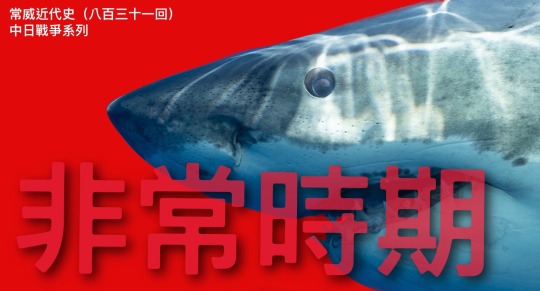
【常威近代史】(八百三十一回)
非常時期非常做法
時間先去到1940年嘅8月,8月1號,冀南、太行、太嶽,三個解放區成立統一嘅行政聯合辦事處,簡單啲嚟講,即係成立政權(蘇維埃),國民黨蔣介石一直提防中共擴張勢力,不過亦都無能為力。兵荒馬亂,佢自己退守大後方重慶,泥菩薩過江自顧不暇,其實仲邊有能力抑壓中共勢力不斷坐大?8月1號,修建接近8年嘅國立中央圖書館喺南京開幕,館長係蔣復璁(1898—1990),蔣復璁係浙江省海寧人。北京大學哲學系畢業,曾公費到德國柏林大學進修圖書館學。曾任職國立北平圖書館(中國國家圖書館前身)、國立中央圖書館第一任館長,亦係1965年在台北市士林區外雙溪重建國立故宮博物院的首任院長。與金庸(查良鏞,1924-2018)有親戚關係,金庸稱其為「表哥」。
8月1號,上海國華電影公司電影《孟麗君》上映,而8日前,春明電影公司嘅同名電影已經上映咗,一套戲鬧雙胞胎。「國華電影公司」與同行打擂臺並不只有依一次,今年6月3號,藝華公司上映《三笑》,10號,國華嘅《三笑》亦都上映。7月4號,華新電影公司推出《碧玉簪》,7月8號國華亦都推出自己嘅《碧玉簪》電影。當其時,親日嘅中華電影股份有限公司壟斷咗淪陷區嘅影片發行業,為咗令到自己嘅影片擴大市場,電影商便爭拍與時事無關嘅民間故事片,打仗期間,避談政治都係理所當然。電影製作嘅速度喺當時都快得驚人,國華電影公司拍《三笑》只用咗8日,而藝華只用咗7日。香港嘅粵語片時代,亦有所謂「七日鮮」,即係7日拍一部戲,粗製濫造實屬正常。電影鬧雙胞胎亦都係常見嘅事,香港過去就有《葉問》電影鬧雙胞胎事件,不過今時今日香港搵鬼睇戲,獨生仔都湊唔大,點會再有雙胞胎?
8月2號,日本外相松岡洋右(1880-1946)聲言已以日、滿、華爲樞紐,解決中國事件。日即係日本,滿即係偽滿洲國,而華即係汪偽政權。蔣介石嘅重慶政權係非法嘅,中共更加唔使講。松岡洋右曾經處理過日本退出國際聯盟,簽定日德意三國軸心國聯盟,日蘇中立條約等太平洋戰爭爆發前日本外交多次重要事件。日本投降後,響同盟國召開嘅東京軍事法庭審判中途病亡。
8月4號,晉西北根據地進行交通破襲戰,奮戰8日,毀同蒲綫大同至曲陽段,及汾離公路全綫,破壞日本人嘅運輸路線。響一場戰爭裡面,運輸係非常重要一環,大佬唔係喐下就核平對方吓嘛?三軍未動,糧草先行。冇辦法將糧草、武器同士兵送到交戰之處,就算幾惡都冇用。8月6號,越南法國總督同日軍代表簽約,允許日軍登陸海防。
8月7號,中蘇新商約簽字。同一日,國民政府財政部公佈《非常時期銀行管理暫行辦法》,更集中地控制國統區內嘅金融。《非常時期銀行管理暫行辦法》等十條,主要內容包括:各間銀行經收嘅普通存款,應以所收總額嘅20%為準備金,轉存當地中央銀行、中國銀行、交通銀行、農民銀行四行任何一行,即係你存100蚊入銀行,政府就抽起你20蚊,真正非常時期非常措施;另外,政府亦都規定每間銀行應準備存款放款匯款報告表,呈交財政部查核,表格方式由財政部規定;而財政部更可隨時派員檢查銀行賬冊、薄藉、庫存狀況及其他文件。財政部權力無限大,隨時可以向銀行查賬,唔俾你走資,更唔畀你勾結日本人或共産黨。《暫行辦法》又規定對違反該辦法者處以3000蚊以上,10000蚊以下,或所經營業務金額50%以下嘅罰款,罰款嘅數目亦都非常浮動,價錢任佢開。
今日睇返,叫嚴重干預自由市場,但戰爭時期,政權生死攸關,唔通唔管咩?呢個世界有一樣嘢,要永遠排喺第一位,相對起呢樣嘢,其餘一切皆不重要,依一樣嘢叫做:「國家安全」。香港人過去對「國家安全」概念非常薄弱,因爲我哋係響英國殖民地被教育下長大,英國人當然會向香港人灌輸「中國國家安全」依個概念,凡事都係因果。
8月8號,豫北沁陽日軍掘潰沁河堤,沁陽一帶成為澤國,同日,國民政府公告徵收戰時所得稅,特別徵稅項目用作戰爭開資,亦都係非常正常之事。8月10號,臺灣電力公司合併臺灣、合同電器等三間公司。8月11號,蔣介石發表《告四川省民衆書》,宣佈即時實行糧食管制;今日,日本派出90架轟炸機轟炸重慶,被擊落5架。
8月14號,豫東暴雨成災,太康、邱營、黃口等縣災情嚴重。今日,青幫領袖,預備浙江省主席張嘯林被軍統特務殺死。張嘯林(1877—1940),民國初年知名黑道人物,浙江寧波人,上海青幫頭目,國民革命軍少將,名張寅。加入青幫後,與黃金榮(1868-1953)、杜月笙(1888-1951)並稱為「上海青幫三大亨」,簡稱「上海三大亨」,上海人講「黃金榮愛錢,張嘯林善打,杜月笙會做人」之說,抗日戰爭時期,張嘯林投靠汪偽政權。今日,中共軍人,十大元帥之一徐向前(1901-1990)部隊接管國民黨山東省政府駐地魯村。
8月16號,行政院通領取締囤積;8月18號,日軍攻陷山東魯村,徐向前部隊撤退。8月19號,190架日本飛機轟炸重慶市區,同一日,川康鹽管局籌設戰時食鹽購銷處,以利食鹽統購統銷。8月19號,臺灣省總督府宣佈人口統計數字,全臺灣人口自1939年末,已達到5,895,864人。
#常威💀 #蔣介石平反系列 #佛經抄寫員 #中日戰爭 #中華民國
0 notes
Photo

荷红莲碧#China #Zhejiang #Hangzhou #Westlake #Guo’sVilla #lotus #beautiful #travel #landscape #citywalk #summer #lake (在 汾陽别墅(郭庄) Guo's Villa) https://www.instagram.com/p/BzFK8d9BecV/?igshid=1p4w22qi7iwhc
2 notes
·
View notes
Text
粒史學加000361《史記》卷二十八〈封禪書〉18:兩千年前的一場詐騙事件
──────────原文────────── 其明年,趙人新垣平以望氣見上,言「長安東北有神氣,成五采,若人冠糸免焉。或曰東北神明之舍,西方神明之墓也。天瑞下,宜立祠上帝,以合符應」。於是作渭陽五帝廟,同宇,帝一殿,面各五門,各如其帝色。祠所用及儀亦如雍五畤。 夏四月,文帝親拜霸渭之會,以郊見渭陽五帝。五帝廟南臨渭,北穿蒲池溝水,權火舉而祠,若光煇然屬天焉。於是貴平上大夫,賜累千金。而使博士諸生刺六經中作王制,謀議巡狩封禪事。 文帝出長門,若見五人於道北,遂因其直北立五帝壇,祠以五牢具。 其明年,新垣平使人持玉杯,上書闕下獻之。平言上曰:「闕下有寶玉氣來者。」已視之,果有獻玉杯者,刻曰「人主延壽」。平又言「臣候日再中」。居頃之,日卻復中。於是始更以十七年為元年,令天下大酺。 平言曰:「周鼎亡在泗水中,今河溢通泗,臣望東北汾陰直有金寶氣,意周鼎其出乎?兆見不迎則不至。」於是上使使…

View On WordPress
0 notes
Text
The Water Classic: Part 2
[This is the core Classic only, i.e. without the Commentary, however the headings, SJZ01, SJZ02, etc., indicates the corresponding scrolls within the much longer Commentary on the Water Classic.]
[The maps are primarily intended to illustrate the Classic. Place names have as far as possible been placed in accordance with the Historic Atlas of China, and the rivers drawn as straight lines between their closest vicinity to each place. The Classic is not error-free, as is made clear in the Commentary. Unless noted otherwise, discrepancies between the Atlas and the Classic have been resolved in favour of the Atlas. Cities, mountains, rivers and other features not in the Atlas have been placed by me to fit the description in the Classic.]
[The Ji River is interesting as a once quite important river that no longer exists.]

Dongguo River洞過水 sets out from a mountain north of Zhan County沾縣, goes west to pass south of Yuci County榆次縣, again west to arrive south of Jinyang County晉陽縣, and to the west enters the Fen汾, making a mouth below the Jin River晉水[?].
Jin River晉水 sets out from Xuanweng懸甕山 west of Jinyang County晉陽縣, again goes south to pass south of that county, and to the east enters into Fen River汾水.
[During Western Zhou, Xie of Tang, a grandson of King Wu, relocated his capital to the north bank of the Jin river, and became known as the Marquis of Jin.]
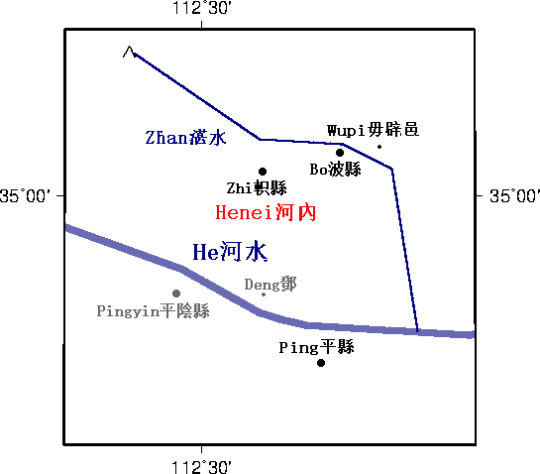
Zhan River湛水 sets out from a mountain north-west of Henei's河內 Zhi County軹縣, goes east to pass north of that county, again east to pass north of Bo County波縣, again east to pass south of Wupi Town毋辟邑, again south-east to north-east of Ping County平縣, where to the south it enters the He河.
[According to the Commentary, the river described above was actually named the Qu River湨水, while the Zhan湛 was a different, smaller river that entered the He near Deng鄧.
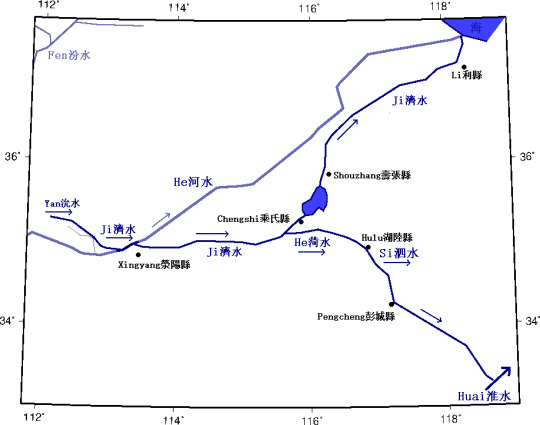

Ji River濟水 sets out from Wangwu Mountain王屋山 east of Hedong's河東 Yuan County垣縣 as the Yan River沇水, again east it arrives north-west of Wen County溫縣 and becomes the Ji River濟水. Again it goes east to pass north of that county, bends from the county to flow south-east, passing west of Tui City隤城, again south to the north of Gong County鞏縣, it to the south enters the He河. It combines flow with the He河, again goes east to pass north of Chenggao County成臯縣, again east to pass north of Xingyang County滎陽縣, again east to arrive south of Li Creek礫溪, and sets out east to pass north of Xing Marsh滎澤. Again going east to pass north of Yangwu County陽武縣, again east to pass north of Fengqiu County封丘縣, again east to pass south of Pingqiu County平丘縣, again east to pass north of Jiyang County濟陽縣, again east to pass south of Yuanqu County冤朐縣, again east to pass south of Dingtao County定陶縣, again bends to flow north-east from the county.
SJZ08
Again east it arrives west of Chengshi County乘氏縣, and divides to become two.
[The Ji River as a branch of the He no longer exists due to changes in the river courses in the centuries since the Classic was written.]
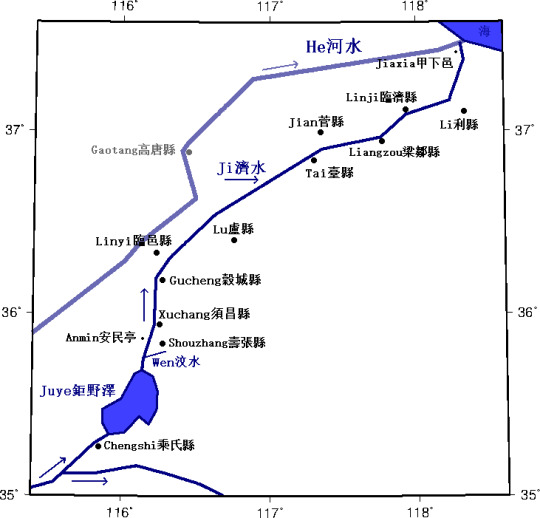
One of the rivers flows south-east, one of the rivers flows north-east from the county, and enters Juye Marsh鉅野澤. Again it goes north-east to pass south of Anmin Precinct安民亭 on the western boundaries of Shouzhang County壽張縣, Wen River 汶水 comes from the north east to pour into it, again north to pass west of Xuchang County須昌縣, again north to pass west of Gucheng County穀城縣, again north to pass east of Linyi County臨邑縣, again north-east to pass north of Lu County盧縣, again north-east to pass north of Tai County臺縣, again north-east to pass south of Jian County菅縣, again east to pass north of Liangzou County梁鄒縣, again north-east to pass south of Linji County臨濟縣, again north-east to pass west of Li County利縣, again north-east to pass Jiaxia Town甲下邑, and enters the He河.
[The Commentary notes that the Ji actually entered the sea separately
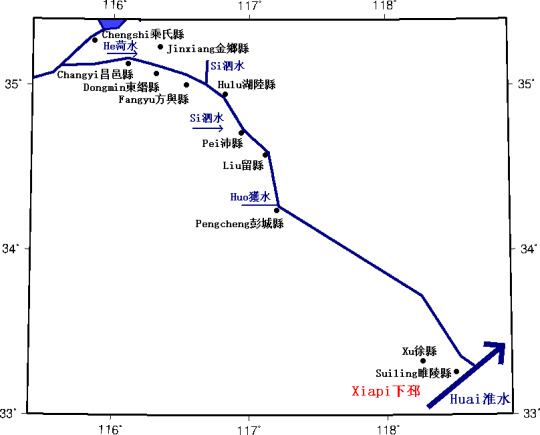
The river that flows south-east passes south of Chengshi County乘氏縣, again goes east to pass north of Changyi County昌邑縣, again east to pass south of Jinxiang County金鄉縣, again east to pass north of Dongmin County東緡縣, again east to pass north of Fangyu County方與縣 to become He River菏水. He River菏水 again goes east to pass south of Hulu County湖陸縣, and to the east enters Si River泗水. Again it goes south-east to pass north-east of Pei County沛縣, again south-east to pass north of Liu County留縣, again east to pass north of Pengcheng County彭城縣, Huo River獲水 came from the west to pour into it, again south-east to pass north of Xu County徐縣, again east to arrive south of Xiapi's下邳 Suiling County睢陵縣, and enter the Huai淮.
[The He River菏水 was a manmade channel dug out to connect the Ji with Si (and so ultimately with the Huai.]
4 notes
·
View notes
Text
31省份新增本土“1173+15239”
31省份新增本土“1173+15239”
2022-04-05 20:52來源: 未知
4月5日,國家衛生健康委網站通報:4月4日0—24時,31個省(自治區、直轄市)和新疆生產建設兵團報告新增確診病例1235例。
其中境外輸入病例62例(四川34例,山東6例,廣東6例,廣西5例,上海3例,河南3例,北京2例,福建2例,天津1例),含21例由無症狀感染者轉為確診病例(四川14例,河南3例,天津1例,福建1例,廣東1例,廣西1例);
本土病例1173例,分別在
吉林792例,其中長春市604例、吉林市175例、白城市10例、白山市2例、四平市1例;
上海268例,其中浦東新區204例、閔行區12例、黃浦區10例、楊浦區10例、徐匯區7例、松江區6例、普陀區4例、虹口區4例、嘉定區4例、寶山區2例、奉賢區2例、長寧區1例、靜安區1例、青浦區1例;
黑龍江17例,其中哈爾濱市13例、牡丹江市4例;
浙江17例,其中嘉興市9例、湖州市4例、寧波市3例、溫州市1例;
山東14例,其中濟南市11例、青島市3例;
四川12例,其中成都市10例、樂山市2例;
北京8例,其中朝陽區6例、豐臺區1例、順義區1例;
江蘇7例,其中徐州市3例、淮安市1例、鹽城市1例、鎮江市1例、宿遷市1例;
福建7例,其中泉州市6例、廈門市1例;
河北6例,均在邯鄲市;
山西4例,其中太原市1例、晉中市1例、運城市1例、臨汾市1例;
遼寧3例,均在鞍山市;
廣東3例,其中廣州市2例、茂名市1例;
天津2例,均在西青區;
江西2例,均在南昌市;
廣西2例,均在百色市;
雲南2例,其中昭通市1例、紅河哈尼族彝族自治州1例;
青海2例,均在西寧市;
內蒙古1例,在通遼市;
安徽1例,在六安市;
海南1例,在儋州市;
貴州1例,在黔西南布依族苗族自治州;
新疆1例,在烏魯木齊市。
以上含100例由無症狀感染者轉為確診病例(吉林74例,浙江6例,四川5例,上海4例,河北3例,福建3例,山東3例,天津1例,江蘇1例)。
今日無新增死亡病例。無新增疑似病例。
當日新增治癒出院病例1899例,解除醫學觀察的密切接觸者26683人,重症病例較前一日增加9例。
境外輸入現有確診病例591例(無重症病例),現有疑似病例17例。累計確診病例17705例,累計治癒出院病例17114例,無死亡病例。
截至4月4日24時,據31個省(自治區、直轄市)和新疆生產建設兵團報告,現有確診病例25060例(其中重症病例63例),累計治癒出院病例127680例,累計死亡病例4638例,累計報告確診病例157378例,現有疑似病例17例。累計追蹤到密切接觸者2456979人,尚在醫學觀察的密切接觸者387696人。
31個省(自治區、直轄市)和新疆生產建設兵團報告新增無症狀感染者15355例。
其中境外輸入116例;
本土15239例,分別在:
上海13086例,其中浦東新區6788例、閔行區1370例、徐匯區1223例、黃浦區973例、虹口區604例、松江區563例、青浦區319例、寶山區267例、普陀區255例、嘉定區243例、楊浦區215例、奉賢區68例、靜安區59例、金山區52例、崇明區49例、長寧區38例;
吉林1680例,其中長春市1336例、吉林市339例、白城市4例、白山市1例;
河北106例,其中邯鄲市65例、保定市39例、石家莊市1例、滄州市1例;
江蘇70例,其中蘇州市27例、宿遷市27例、南通市9例、徐州市5例、鎮江市2例;
遼寧54例,其中瀋陽市46例、鞍山市5例、營口市3例;
安徽48例,其中淮南市37例、阜陽市8例、蕪湖市2例、宣城市1例;
江西39例,其中南昌市31日本藤素 日本藤素屈臣氏
日本藤素正品 japan tengsu
日本藤素進口 日本藤 素 價錢
日本藤素官網 日本藤素哪裡買
日本藤素評價 日本藤素ptt
日本藤素副作用 日本藤素吃法
日本藤素官網總代理 日本藤素香港屈臣氏
日本藤素臺灣官網入口
例、上饒市6例、撫州市2例;
河南31例,其中周口市22例、永城市8例、鄭州市1例;
浙江25例,其中嘉興市17例、杭州市4例、溫州市3例、麗水市1例;
山東17例,其中臨沂市7例、濰坊市4例、棗莊市3例、濟南市1例、威海市1例、菏澤市1例;
湖北16例,其中隨州市12例、武漢市3例、鄂州市1例;
雲南14例,其中德宏傣族景頗族自治州11例、紅河哈尼族彝族自治州2例、曲靖市1例;
黑龍江10例,其中佳木斯市5例、牡丹江市3例、哈爾濱市1例、黑河市1例;
福建9例,其中泉州市7例、福州市1例、寧德市1例;
四川9例,其中成都市4例、樂山市4例、遂寧市1例;
新疆8例,其中烏魯木齊市6例、昌吉回族自治州1例、巴音郭楞蒙古自治州1
0 notes